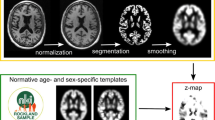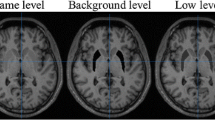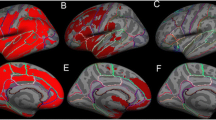Abstract
Objective
To assess the utility of the motion correction method with prospective motion correction (PROMO) in a voxel-based morphometry (VBM) analysis for ‘uncooperative’ patient populations.
Methods
High-resolution 3D T1-weighted imaging both with and without PROMO were performed in 33 uncooperative patients with Parkinson's disease (n = 11) or dementia (n = 22). We compared the grey matter (GM) volumes and cortical thickness between the scans with and without PROMO.
Results
For the mean total GM volume with the VBM analysis, the scan without PROMO showed a significantly smaller volume than that with PROMO (p < 0.05), which was caused by segmentation problems due to motion during acquisition. The whole-brain VBM analysis showed significant GM volume reductions in some regions in the scans without PROMO (familywise error corrected p < 0.05). In the cortical thickness analysis, the scans without PROMO also showed decreased cortical thickness compared to the scan with PROMO (p < 0.05).
Conclusion
Our results with the uncooperative patients indicate that the use of PROMO can reduce misclassification during segmentation of the VBM analyses, although it may not prevent GM volume reduction.
Key Points
• Motion artifacts pose significant problems for VBM analyses.
• PROMO correction can reduce the motion artifacts in high-resolution 3D T1WI.
• The use of PROMO may improve the precision of VBM analyses.



Similar content being viewed by others
Abbreviations
- EKF:
-
Extended Kalman filter
- GM:
-
Grey matter
- MPRAGE:
-
Magnetization-prepared Rapid Acquisition Gradient Echo
- PROMO:
-
Prospective motion correction
- T1WI:
-
T1-weighted imaging
- VBM:
-
Voxel-based morphometry
References
Agarwal N, Port JD, Bazzocchi M, Renshaw PF (2010) Update on the use of MR for assessment and diagnosis of psychiatric diseases. Radiology 255:23–41
Atiya M, Hyman BT, Albert MS, Killiany R (2003) Structural magnetic resonance imaging in established and prodromal Alzheimer disease: a review. Alzheimer Dis Assoc Disord 17:177–195
Waragai M, Hata S, Suzuki T et al (2014) Utility of SPM8 plus DARTEL (VSRAD) combined with magnetic resonance spectroscopy as adjunct techniques for screening and predicting dementia due to Alzheimer's disease in clinical practice. J Alzheimers Dis 41:1207–1222
Hirata Y, Matsuda H, Nemoto K et al (2005) Voxel-based morphometry to discriminate early Alzheimer's disease from controls. Neurosci Lett 382:269–274
Schmitter D, Roche A, Marechal B et al (2015) An evaluation of volume-based morphometry for prediction of mild cognitive impairment and Alzheimer's disease. Neuroimage Clin 7:7–17
Cuingnet R, Gerardin E, Tessieras J et al (2011) Automatic classification of patients with Alzheimer's disease from structural MRI: a comparison of ten methods using the ADNI database. NeuroImage 56:766–781
Blumenthal JD, Zijdenbos A, Molloy E, Giedd JN (2002) Motion artifact in magnetic resonance imaging: implications for automated analysis. NeuroImage 16:89–92
Brown TT, Kuperman JM, Erhart M et al (2010) Prospective motion correction of high-resolution magnetic resonance imaging data in children. NeuroImage 53:139–145
Reuter M, Tisdall MD, Qureshi A, Buckner RL, van der Kouwe AJ, Fischl B (2015) Head motion during MRI acquisition reduces gray matter volume and thickness estimates. Neuroimage 107:107–115
White N, Roddey C, Shankaranarayanan A et al (2010) PROMO: Real-time prospective motion correction in MRI using image-based tracking. Magn Reson Med 63:91–105
Tisdall MD, Hess AT, Reuter M, Meintjes EM, Fischl B, van der Kouwe AJ (2012) Volumetric navigators for prospective motion correction and selective reacquisition in neuroanatomical MRI. Magn Reson Med 68:389–399
Tisdall MD, Reuter M, Qureshi A, Buckner RL, Fischl B, van der Kouwe AJ (2016) Prospective motion correction with volumetric navigators (vNavs) reduces the bias and variance in brain morphometry induced by subject motion. Neuroimage 127:11–22
Kuperman JM, Brown TT, Ahmadi ME et al (2011) Prospective motion correction improves diagnostic utility of pediatric MRI scans. Pediatr Radiol 41:1578–1582
Jovicich J, Czanner S, Greve D et al (2006) Reliability in multi-site structural MRI studies: effects of gradient non-linearity correction on phantom and human data. Neuroimage 30:436–443
Ashburner J (2009) Computational anatomy with the SPM software. Magn Reson Imaging 27:1163–1174
Fischl B (2012) FreeSurfer. NeuroImage 62:774–781
Fischl B, Salat DH, Busa E et al (2002) Whole brain segmentation: automated labeling of neuroanatomical structures in the human brain. Neuron 33:341–355
Maclaren J, Han Z, Vos SB, Fischbein N, Bammer R (2014) Reliability of brain volume measurements: A test-retest dataset. Sci Data 1:140037
Kempton MJ, Salvador Z, Munafo MR et al (2011) Structural neuroimaging studies in major depressive disorder. Meta-analysis and comparison with bipolar disorder. Arch Gen Psychiatr 68:675–690
Holland D, Brewer JB, Hagler DJ, Fennema-Notestine C, Dale AM, Alzheimer's Disease Neuroimaging I (2009) Subregional neuroanatomical change as a biomarker for Alzheimer’s disease. Proc Natl Acad Sci U S A 106:20954–20959
Acknowledgements
This work was technically supported by Scientific Research on Innovative Areas (Comprehensive Brain Science Network) from the Ministry of Education, Science, Sports and Culture of Japan.
Author information
Authors and Affiliations
Corresponding author
Ethics declarations
Guarantor
The scientific guarantor of this publication is Yukunori Korogi.
Conflict of interest
The authors of this manuscript declare no relationships with any companies whose products or services may be related to the subject matter of the article.
Funding
The authors state that this work has not received any funding.
Statistics and biometry
No complex statistical methods were necessary for this paper.
Ethical approval
Institutional Review Board approval was obtained.
Informed consent
Written informed consent was obtained from all subjects (patients) in this study.
Study subjects or cohorts overlap
Any study subjects or cohorts have not been previously reported.
Methodology
-
prospective
-
observation
-
performed at one institution
Rights and permissions
About this article
Cite this article
Igata, N., Kakeda, S., Watanabe, K. et al. Utility of real-time prospective motion correction (PROMO) for segmentation of cerebral cortex on 3D T1-weighted imaging: Voxel-based morphometry analysis for uncooperative patients. Eur Radiol 27, 3554–3562 (2017). https://doi.org/10.1007/s00330-016-4730-7
Received:
Revised:
Accepted:
Published:
Issue Date:
DOI: https://doi.org/10.1007/s00330-016-4730-7




